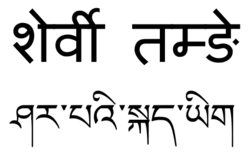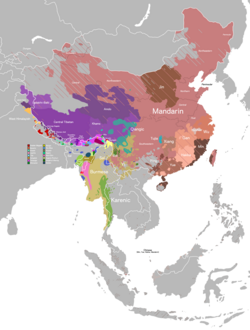Sherpa language
Sherpa (also Sharpa, Sherwa, or Xiaerba) is a Tibetic language spoken in Nepal and the Indian state of Sikkim, mainly by the Sherpa. The majority speakers of the Sherpa language live in the Khumbu region of Nepal, spanning from the Chinese (Tibetan) border in the east to the Bhotekosi River in the west.[3] About 127,000 speakers live in Nepal (2021 census), some 16,000 in Sikkim, India (2011), and some 800 in the Tibetan Autonomous Region (1994). Sherpa is a subject-object-verb (SOV) language. Sherpa is predominantly a spoken language, although it is occasionally written using either the Devanagari or Tibetan script.[3] ClassificationSherpa belongs to the Tibetic branch of the Tibeto-Burman family. It is closely related to Central Tibetan, Jirel, Humla, Mugom, Dolpo, Lo-ke, Nubri, Tsum, Langtang, Kyirong, Yolmo, Gyalsumdo, Kagate, Lhomi, Walung, and Tokpe Gola. The Sherpa language five closely related dialects, these being Solu, Khumbu, Pharak, Dram, and Sikkimese Sherpa.[4] PhonologySherpa is a tonal language.[5][6] Sherpa has the following consonants:[7] Consonants
Vowels
TonesThere are four distinct tones; high /v́/, high falling /v̂/, low /v̀/, and low rising /v̌/. Regardless of the regular tone of the word, the last syllable of a question is to be pronounced with a rising tone. GrammarVerbsVerb stems are modified for aspect and mood. The imperfective and perfective aspects and the volitional (whether an action was intentional), infinitive, disjunct, and imperative (commands) moods are differentiated. In verb suffixes, the infinitive, disjunct (action not intended or not known to be intended), past observational, mirative (speaker's surprise), volitional, augmentative (greater intensity), participle, durative (action lasts through an extended time), hortative (plural imperative), dictative (narrating a story), descentive, ablative, and locative are distinguished. A verb stem may take on up to three suffixes. The perfective and imperfective aspects are often treated as past and non-past tenses, respectively. The labels "locative" and "ablative" do not refer to the function of the aspect but rather the homomorphous case-like clitic of the same name. Sherpa is strictly verb-final.
The infinitive also marks the verb of a relative clause and a general action with no specific subject. ɲɛ 1SG.GEN pèt̪-u spill.PRF-INF čʰū water t̪í DEF t̪èŋa cold nɔ́k MIR The water that I spilled is cold The ablative marking denotes successive actions with some causal relationship. t̪í-ci 3SG-GEN dzím-ne catch.PRF-ABL gal go.PRF.DSJT He caught (it) and went The locative marking denotes when the action in the main clause is done for the purpose of achieving the action in the locative clause. d̪am-i PROPER.FEM-GEN sa-p-la eat.IMPF-INF-LOC sʌma food tsò-suŋ cook.PRF.DSJT-POBS Damu cooked food in order to eat The copula(Imperfective hín, perfective hot̪u)is used for existence, location, identity, and adjectival predicates. The evidential particle wɛ́ occurs at the end of phrases to denote an action which the speaker witnessed. The negative particle má is used with perfective verbs. NounsThere are four case-like clitics in Sherpa: nominative, genitive, locative, and ablative. These can also be used to mark arguments of a verb. There is a split-ergative system based on aspect; nominative-accusative in the imperfective and ergative-absolutive in the perfective.[8] PronounsPersonal pronouns in Sherpa inflect for number and case. Third-person pronouns may be used as demonstratives, and the third person singular nominative also serves as the postnominal definite marker.
There are two articles, which occur phrase-finally. The indefinite form is signaled with the enclitic -i at the end of a noun phrase. AdjectivesThe general word order within noun-phrases is Noun-Adjective. Quantifiers and numerals also follow the noun they modify. Numerals may take on the suffix -pa to denote ordinality or -kʌr to denote collectivity.
Sample textThe following is a sample text in Sherpa of Article 1 of the Universal Declaration of Human Rights: Sherpa in Devanagari script
Sherpa in Tibetan script
Sherpa in IAST transliteration
Sherpa in the Wylie transliteration
Translation
References
External links
|
|||||||||||||||||||||||||||||||||||||||||||||||||||||||||||||||||||||||||||||||||||||||||||||||||||||||||||||||||||||||||||||||||||||||||||||||||||||||||||||||||||||||||||||||||||||||||||||||||||||||||||||||||||||||||||||||||||||||||||||||||||||||||||||||||















